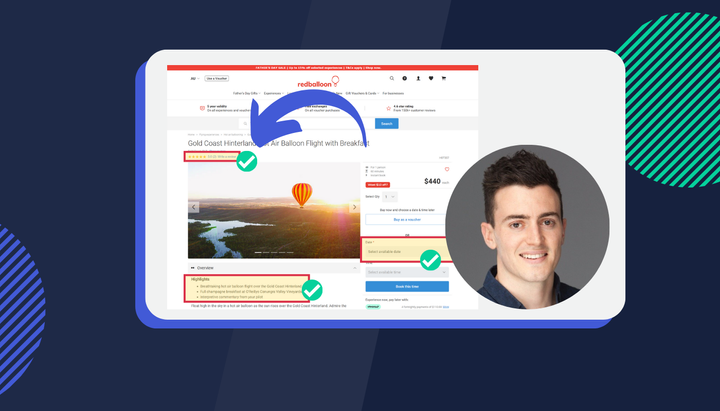Communicating Analytics in Large Enterprises: A Conversation with Adam King
Creating an effective analytics culture goes beyond just collecting data. You need to master communicating insights to build credibility and grow your influence with internal stakeholders.

Welcome, readers. Today, I had the privilege of speaking with Adam King, an expert in the field of digital analytics and personalisation. Having been with some of the financial giants like Commonwealth Bank and IAG, his insights about analytics in large enterprises are golden.
Here's a detailed breakdown of our conversation:
- - -
Andrew: To kick things off, Adam, could you tell us about treating analytics as a product for our internal audience?
Adam: Sure, Andrew. Over the years, I've come to understand the value of approaching analytics as a product. This isn't just about numbers and data; it's about understanding how people consume those numbers. How do they interpret insights and analytics? Every product starts with research and discovery. Same with analytics. You need to know your audience, be aware of existing gaps, and continuously review the tools at hand. It's essential to tailor your approach based on the team's role and seniority. For someone just starting, I’d say consider your current position and gradually inculcate a product mindset within your analytics team. This encourages a richer analytical culture. But remember to start small. MVPs and rough designs can sometimes be more insightful than a finished product. It’s about resonance, what clicks with the audience. Always define what success looks like for both the company and your team. Metrics should not only make sense but should be aligned with the broader business objectives.
Making data and analytics easy to understand is the name of the game. I recall a situation where no one was consuming our reports. The solution? We visualised the data.
Andrew: That’s insightful. So, North Star metrics play a significant role here?
Adam: Absolutely. Identifying core metrics is the crux. Begin with what your stakeholders prioritise and then cascade down. A digital acquisition firm, for instance, would pivot around metrics associated with acquisition and retention.
Building a robust data culture in massive corporations is a daunting task. Remember our conversation about approaching analytics with a product mindset? That's a start. But fostering this culture requires training, visibility, and continuous engagement. Making data accessible and visual is vital.
Andrew: How do you think organisations, especially large enterprises, should approach starting an analytics project?
Adam: Good question. In vast, complex organisations, you need a strategy and roadmap. This not only ensures clarity but also helps gain the necessary buy-ins. Linking your projects to your North Star metrics is a great way to keep the momentum going and not let the excitement die down. Essentially, it's about marketing your insights internally to your stakeholders.
In vast, complex organisations, you need a strategy and roadmap. This not only ensures clarity but helps gain the necessary buy-ins.
Andrew: Chris from our audience asks how to navigate situations where data contradicts pre-existing perceptions.
Adam: Ah, the age-old battle of perception vs. data! It's often said that data sets you free. But in my experience, it's not always that straightforward, especially if the organisational culture isn’t geared toward analytics. When there's a mismatch, it's our job to build a compelling story around that data. Most individuals in big firms are looking to make a positive impact. So, the idea is to bridge the gap between data and perception. And yes, it's a skill, sometimes even an art, to navigate these waters.
Andrew: Speaking of navigating waters, Richard asks about the potential barriers to successful analytics functions.
Adam: Barriers can be multifaceted. It could be the mindset of the people, the technological backbone, or even external stakeholders. Each organisation faces a unique blend of these challenges.
Andrew: Let’s talk about visual analytics. How do they revolutionise the way analytics and insights are communicated?
Adam: Making data and analytics easy to understand is the name of the game. I recall a situation where no one was consuming our reports. The solution? We visualised the data. Charts, funnels on walls, TV screens flashing real-time data - it changed the way the company saw and used data. Tools like session replays are so crucial here. Though the idea of session recordings has been around, it's gaining traction now. However, there’s still some resistance due to misconceptions about data security and the constant evolution of privacy laws. But the potential value is undeniable.
Andrew: Data culture is a term we often hear. Could you share your strategies for fostering this culture?
Adam: Building a robust data culture in massive corporations is a daunting task. Remember our conversation about approaching analytics with a product mindset? That's a start. But fostering this culture requires training, visibility, and continuous engagement. Making data accessible and visual is vital. Dedicated training sessions can mitigate the Fear Factor around data. We need an environment where data is openly discussed, challenged, and leveraged for decision-making. Over time, I've found value in boot camps, online resources like webinars, and even internal certifications to upskill employees. Celebrating achievements, creating a competitive environment, and showcasing success stories keep the momentum alive. And never underestimate the power of being visible. It might sound old-school, but roadshows within a massive corporation can do wonders.
Andrew: In a nutshell, making analytics relatable to what your audience cares about is the key.
Adam: Precisely. It’s all about aligning your analytical insights with the broader business objectives of your organisation. When the two resonate, magic happens.



